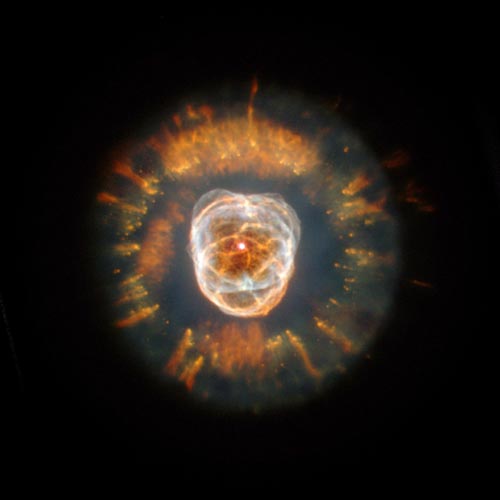
Description: Planetary Nebula
Position (J2000): R.A. 07h 29m 10.77s Dec. +20° 54' 42.5"
Constellation: Gemini
Distance: 5,000 light-years (1,500 parsecs)
Instrument: WFPC2
Exposure Date(s): January 10 and 11, 2000
Exposure Time: 1 hour
Filters: F469N (He II), F502N ([O III]), F656N (H-alpha),F658N ([N II])
Image Credit: NASA, A. Fruchter and the ERO Team (STScI)
Release Date: January 24, 2000
ABOUT THIS IMAGE:
In
its first glimpse of the heavens following the successful December 1999
servicing mission, NASA's Hubble Space
Telescope has captured a majestic view of a planetary nebula, the glowing
remains of a dying, Sun-like star. This
stellar relic, first spied by William Herschel in 1787, is nicknamed the
"Eskimo" Nebula (NGC 2392) because, when
viewed through ground-based telescopes, it resembles a face surrounded
by a fur parka. In this Hubble telescope
image, the "parka" is really a disk of material embellished
with a ring of comet-shaped objects, with their tails
streaming away from the central, dying star. The Eskimo's "face"
also contains some fascinating details. Although
this bright central region resembles a ball of twine, it is, in reality,
a bubble of material being blown into space by the
central star's intense "wind" of high-speed material.
The
planetary nebula began forming about 10,000 years ago, when the dying
star began flinging material into space.
The nebula is composed of two elliptically shaped lobes of matter streaming
above and below the dying star. In this
photo, one bubble lies in front of the other, obscuring part of the second
lobe.
Scientists
believe that a ring of dense material around the star's equator, ejected
during its red giant phase, created
the nebula's shape. This dense waist of material is plodding along at
72,000 miles per hour (115,000 kilometers per
hour), preventing high-velocity stellar winds from pushing matter along
the equator. Instead, the 900,000-mile-per-hour
(1.5-million-kilometer-per-hour) winds are sweeping the material above
and below the star, creating the elongated
bubbles. The bubbles are not smooth like balloons but have filaments of
denser matter. Each bubble is about 1
light-<br>year long and about half a light-year wide. Scientists
are still puzzled about the origin of the comet-shaped
features in the "parka." One possible explanation is that these
objects formed from a collision of slow- and fast-moving
gases.
The
Eskimo Nebula is about 5,000 light-years from Earth in the constellation
Gemini. The picture was taken Jan. 10
and 11, 2000, with the Wide Field and Planetary Camera 2. The nebula's
glowing gases produce the colors in this
image: nitrogen (red), hydrogen (green), oxygen (blue), and helium (violet).